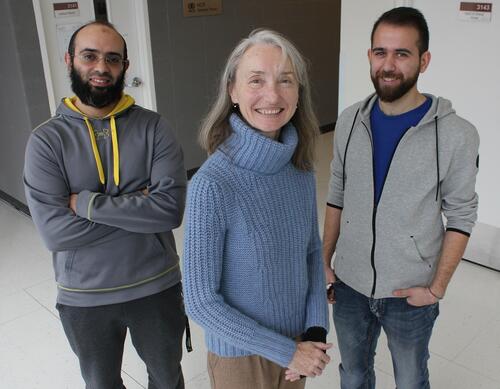
Thwarting attacks on the Internet of Things
Professor Catherine Gebotys and her research group are working on improving security for the Internet of Things

Professor Catherine Gebotys and her research group are working on improving security for the Internet of Things
By Julie Stauffer Faculty of EngineeringIn one corner of Professor Catherine Gebotys' lab, a laser beam is strategically aimed to disrupt circuit board operations. Nearby, electromagnetic pulses bombard an uncapped chip while a couple of graduate students track the results on an oscilloscope screen.
By probing for vulnerabilities that hackers could exploit, her team at the University of Waterloo’s Faculty of Engineering is making the Internet of Things more secure.
They’ve got their work cut out for them. Embedded chips — the kind you find in credit cards, Fitbits, smartphones and a host of other devices — are frequent targets for tech-focused crime.
Take the example of side-channel attacks. When the hardware on a device is encrypting data, Gebotys explains, it gives off electromagnetic waves that can be parsed to reveal the confidential information. Meanwhile, directing laser beams or electromagnetic waves at a device — a so-called fault-injection attack — produces information that hackers can use to infer the encryption key.

Professor Catherine Gebotys (center) poses with PhD student Karim Amin (left) and research associate Mustafa Faraj (right) from her research group working on improving security for the Internet of Things
The implications range from mildly worrying to downright scary. Someone could intercept and decrypt a confidential email to your boss. Your fitness tracker could disclose details about your health and location. The bank information embedded in your debit card could fall into the wrong hands.
To reduce those risks, Gebotys draws on both software and hardware approaches. In the case of side-channel attacks, for instance, her team has developed ways to add electromagnetic noise during encryption. That’s not enough to completely protect confidential information, but it slows an attacker down — hopefully long enough that the system will have changed security keys before the code is broken.
“You can’t always stop all attacks, but you can make them harder,” she says.
Simply developing effective countermeasures isn’t enough, however. They also have to be cost-effective. Banks and credit card companies may be willing to pour big bucks into cyber-protection, but as we start to see hardware systems embedded in everything from lighting systems to baby monitors, manufacturers want security at a price consumers are willing to pay.
Efficiency is another must. There’s no point in adding layers of security to a smartphone if all that extra computation sucks the life out of the battery or slows the device down to a crawl.
“One of our objectives is to make sure it doesn’t take a lot of energy,” Gebotys says.
Her focus on industry-relevant research has attracted a host of big-name partners, focused on developing technology specifically aligned with the Internet of Things. BlackBerry has incorporated some of the lab’s countermeasures into its phones, while companies like Motorola and COM DEV have also tapped her expertise. Currently, Gebotys is working with the Department of National Defence to produce more hacker-resistant hardware.
“The best research — in my opinion — you can do is work on real problems,” Gebotys says.
Waterloo provides the perfect setting for that, she adds, pointing to topnotch students, a “fantastic” co-op engineering program and an emphasis on industry collaborations.

Engineering master's student Nayeema Nonta (left), one of the three paper authors, and her supervisor, Dr. Sirisha Rambhatla, in a large server room with the computer power needed to develop their new LLM training technique. (University of Waterloo)
Read more
Waterloo researchers develop highly efficient AI training system that paves the way for cheaper, greener “intelligent partners”

Read more
Engineering researchers team up to tackle the plastics pollution problem with microbial innovation and engineering design

Read more
15 University of Waterloo researchers have been named to the annual Highly Cited Researchers™ list for significant contributions to their specific fields of research
Read
Engineering stories
Visit
Waterloo Engineering home
Contact
Waterloo Engineering
The University of Waterloo acknowledges that much of our work takes place on the traditional territory of the Neutral, Anishinaabeg, and Haudenosaunee peoples. Our main campus is situated on the Haldimand Tract, the land granted to the Six Nations that includes six miles on each side of the Grand River. Our active work toward reconciliation takes place across our campuses through research, learning, teaching, and community building, and is co-ordinated within the Office of Indigenous Relations.